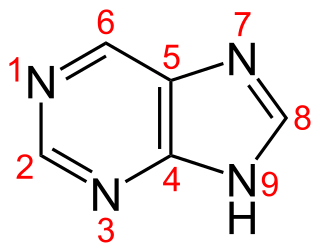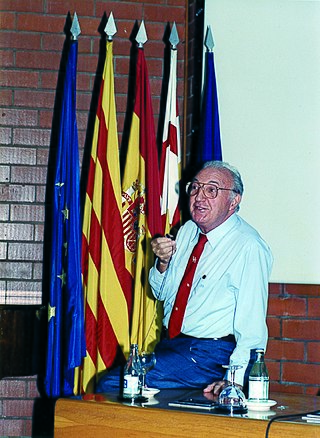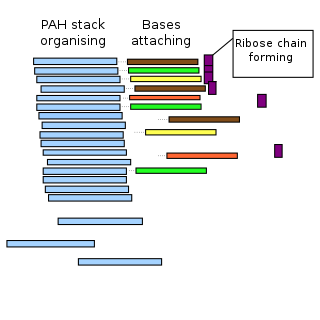
The Miller–Urey experiment (or Miller experiment) was an experiment in chemical synthesis carried out in 1952 that simulated the conditions thought at the time to be present in the atmosphere of the early, prebiotic Earth. It is seen as one of the first successful experiments demonstrating the synthesis of organic compounds from inorganic constituents in an origin of life scenario. The experiment used methane (CH4), ammonia (NH3), hydrogen (H2), in ratio 2:2:1, and water (H2O). Applying an electric arc (the latter simulating lightning) resulted in the production of amino acids.

Purine is a heterocyclic aromatic organic compound that consists of two rings fused together. It is water-soluble. Purine also gives its name to the wider class of molecules, purines, which include substituted purines and their tautomers. They are the most widely occurring nitrogen-containing heterocycles in nature.
Pyrimidine is an aromatic, heterocyclic, organic compound similar to pyridine. One of the three diazines, it has nitrogen atoms at positions 1 and 3 in the ring. The other diazines are pyrazine and pyridazine.
The iron–sulfur world hypothesis is a set of proposals for the origin of life and the early evolution of life advanced in a series of articles between 1988 and 1992 by Günter Wächtershäuser, a Munich patent lawyer with a degree in chemistry, who had been encouraged and supported by philosopher Karl R. Popper to publish his ideas. The hypothesis proposes that early life may have formed on the surface of iron sulfide minerals, hence the name. It was developed by retrodiction from extant biochemistry in conjunction with chemical experiments.

In organic chemistry, an imine is a functional group or organic compound containing a carbon–nitrogen double bond. The nitrogen atom can be attached to a hydrogen or an organic group (R). The carbon atom has two additional single bonds. Imines are common in synthetic and naturally occurring compounds and they participate in many reactions.

Leslie Eleazer Orgel FRS was a British chemist. He is known for his theories on the origin of life.
In organic chemistry, a nitrile is any organic compound that has a −C≡N functional group. The name of the compound is composed of a base, which includes the carbon of the −C≡N, suffixed with "nitrile", so for example CH3CH2C≡N is called "propionitrile". The prefix cyano- is used interchangeably with the term nitrile in industrial literature. Nitriles are found in many useful compounds, including methyl cyanoacrylate, used in super glue, and nitrile rubber, a nitrile-containing polymer used in latex-free laboratory and medical gloves. Nitrile rubber is also widely used as automotive and other seals since it is resistant to fuels and oils. Organic compounds containing multiple nitrile groups are known as cyanocarbons.

Joan Oró i Florensa was a Spanish biochemist, whose research has been of importance in understanding the origin of life. He participated in several NASA missions, including Apollo mission to the Moon and the Viking lander. He received the Oparin Medal, awarded by the International Astrobiology Society for his contributions to the field of origins of life.
1,3,5-Triazine, also called s-triazine, is an organic chemical compound with the formula (HCN)3. It is a six-membered heterocyclic aromatic ring, one of several isomeric triazines. S-triazine—the "symmetric" isomer—and its derivatives are useful in a variety of applications.
The Strecker amino acid synthesis, also known simply as the Strecker synthesis, is a method for the synthesis of amino acids by the reaction of an aldehyde with cyanide in the presence of ammonia. The condensation reaction yields an α-aminonitrile, which is subsequently hydrolyzed to give the desired amino acid. The method is used for the commercial production of racemic methionine from methional.

The PAH world hypothesis is a speculative hypothesis that proposes that polycyclic aromatic hydrocarbons (PAHs), known to be abundant in the universe, including in comets, and assumed to be abundant in the primordial soup of the early Earth, played a major role in the origin of life by mediating the synthesis of RNA molecules, leading into the RNA world. However, as yet, the hypothesis is untested.
Acetone cyanohydrin (ACH) is an organic compound used in the production of methyl methacrylate, the monomer of the transparent plastic polymethyl methacrylate (PMMA), also known as acrylic. It liberates hydrogen cyanide easily, so it is used as a source of such. For this reason, this cyanohydrin is also highly toxic.

Diethylaluminium cyanide is the organoaluminium compound with formula ( 2AlCN)n. This colorless compound is usually handled as a solution in toluene. It is a reagent for the hydrocyanation of α,β-unsaturated ketones.
In organic synthesis, cyanation is the attachment or substitution of a cyanide group on various substrates. Such transformations are high-value because they generate C-C bonds. Furthermore nitriles are versatile functional groups.
The Ritter reaction is a chemical reaction that transforms a nitrile into an N-alkyl amide using various electrophilic alkylating reagents. The original reaction formed the alkylating agent using an alkene in the presence of a strong acid.

Lithium cyanide is an inorganic compound with the chemical formula LiCN. It is a toxic, white coloured, hygroscopic, water-soluble salt that finds only niche uses.
Amino acid N-carboxyanhydrides, also called Leuchs' anhydrides, are a family of heterocyclic organic compounds derived from amino acids. They are white, moisture-reactive solids. They have been evaluated for applications the field of biomaterials.
James "Jim" P. Ferris was an American chemist. He is known for his contributions to the understanding of the origins of life on Earth, specifically by demonstrating a successful mechanism of clay-catalyzed polymerization of RNA, providing further evidence for the RNA World Hypothesis. Additionally, his work in atmospheric photochemistry has illuminated many of the chemical processes which occur in the atmospheres of Jupiter and Saturn's moon, Titan.
Formamide-based prebiotic chemistry is a reconstruction of the beginnings of life on Earth, assuming that formamide could accumulate in sufficiently high amounts to serve as the building block and reaction medium for the synthesis of the first biogenic molecules.
A proto-metabolism is a series of linked chemical reactions in a prebiotic environment that preceded and eventually turned into modern metabolism. Combining ongoing research in astrobiology and prebiotic chemistry, work in this area focuses on reconstructing the connections between potential metabolic processes that may have occurred in early Earth conditions. Proto-metabolism is believed to be simpler than modern metabolism and the Last Universal Common Ancestor (LUCA), as simple organic molecules likely gave rise to more complex metabolic networks. Prebiotic chemists have demonstrated abiotic generation of many simple organic molecules including amino acids, fatty acids, simple sugars, and nucleobases. There are multiple scenarios bridging prebiotic chemistry to early metabolic networks that occurred before the origins of life, also known as abiogenesis. In addition, there are hypotheses made on the evolution of biochemical pathways including the metabolism-first hypothesis, which theorizes how reaction networks dissipate free energy from which genetic molecules and proto-cell membranes later emerge. To determine the composition of key early metabolic networks, scientists have also used top-down approaches to study LUCA and modern metabolism.










